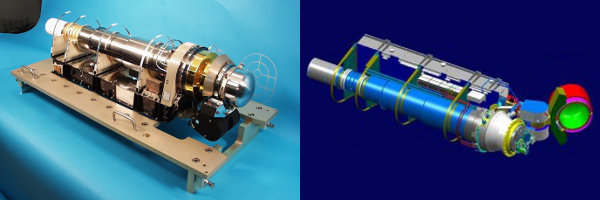
ROSINA – Rosetta Spectrometer for Ion and Neutral Analysis
ROSINA is the main mass spectrometer on the orbiter of ESA’s Rosetta mission to comet 67P/Churyumov-Gerasimenko. It consists of two mass spectrometers for neutrals and ions. ROSINA’s primary objective is to determine the basic properties of the gas in the comet’s atmosphere and ionosphere such as composition, temperature and velocity.
After the launch of Rosetta on March 2nd, 2004, ROSINA was commissioned several times at the European Space Operation Center (ESOC) in Darmstadt (Germany). The instrument proved to be in good health. It will be awakened on 1. April, 2014.
The hardware for the ROSINA mass spectrometers was provided by a consortium from four European countries and the USA under the leadership of the Physikalisches Institut der Universität Bern (Switzerland). Principlal Investigator is K. Altwegg.
Science objectives:
ROSINA’S main goal is to determine the elemental, isotopic, and molecular composition of the comet’s atmosphere and ionosphere. In addition, the scientists are interested in the temperature and the bulk velocity of the gas as well as the reactions of the gas and ions with the dust emitted by the comet.
These results may render important implications for questions regarding the origin of comets, the relation between cometary and interstellar material, and the origin and evolution of the Solar System.
To accomplish these demanding objectives, ROSINA has unprecedented capabilities:
- a wide mass range from 1 amu to more than 300 amu. This makes it possible to detect light atoms such as hydrogen as well as heavy organic molecules.
- a high mass resolution of more than 3000 m/Δm. This means that ROSINA is, for example, able to resolve CO from N2 and 13C from 12CH.
- a wide dynamic range of 1010
- high sensitivity (more than 10-5 A/mbar) to accommodate large differences in ion and neutral gas concentrations and severe changes in the ion and gas flux as the comet’s activity develops between aphelion and perihelion.
Instrument description:
ROSINA consists of two mass spectrometers for neutrals and primary ions with complementary capabilities and a pressure sensor:
- the double focusing magnetic mass spectrometer (DFMS) has a mass range from 1 amu to 150 amu and a mass resolution of 3000 at 1 percent peak height. It is optimized for very high mass resolution and a large dynamic range.
- The reflectron-type time-of-flight mass spectrometer (RTOF) with a mass range from 1 amu to more than 300 amu and a high sensitivity.
- The two pressure gauges (COPS) provide density and velocity measurements of the cometary gas.